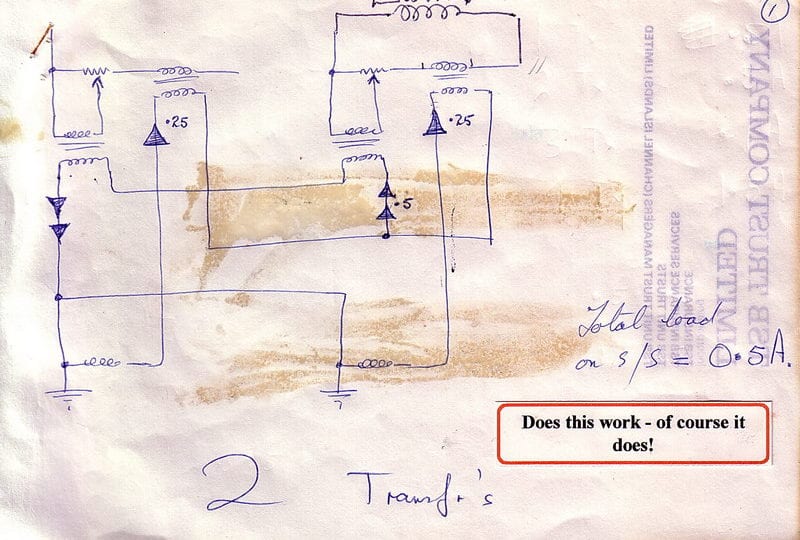Tapping into a problem: 25 years of Fundamentals UK
Fundamentals Ltd is celebrating its 25th anniversary with an amazing team of people and a thriving business. This article gives an overview of how the electrical engineering company has gone from 'garage to greatness' and transformed voltage control for distribution networks.
12th July 2019 by Networks

On the wall at Fundamentals’ head office hangs a frame displaying two hand-drawn electrical diagrams with the words: “Does this work – of course it does!”
The diagrams represent the solution created by Fundamentals co-founders, Nick Hiscock (father to Dr Jon Hiscock (managing director)) and Chris Goodfellow, to a widespread problem associated with voltage control of the HV electrical distribution network.
The duo developed an electrical control circuit they subsequently named the Transformer Automatic Paralleling Package; TAPP was born.
Having proved that it worked, they presented the prototype to Southern Electricity (their employer at the time) and, in return, received a large order to build and deploy the TAPP solution across the network.
In 1985, the two colleagues formalised a partnership and Fundamentals was started. According to Jon: “To solve a problem, you have to break it down to the fundamentals, hence the company name.”
From garage to greatness
To fulfil the Southern Electricity order, Nick and Chris set up a production line at the home of TAPP’s invention – Nick’s garage!
The initial TAPP product grew in scale and sophistication and patents were applied for. With further development, the more comprehensive SuperTAPP product was launched and Fundamentals quickly became the market leader in the UK and commenced exporting into Commonwealth regions.
The company was incorporated as Fundamentals Ltd in 1994 and business turnover had grown to £1 million in just a few years.
A family affair
Jon joined Fundamentals in 2004 and a buyout of Goodfellow’s 50 per cent share of the business followed. Fundamentals took on more technical staff and made its first acquisition; an electrical contracting business owned by Jon’s uncle. By 2008, payroll had grown to 13 and the company was becoming more involved in tapchanger-related work by virtue of SuperTAPP installation work. Following this, Jon met MR (Maschinenfabrik Reinhausen) and Fundamentals won a contract to become their agent.
Changing times
Over the subsequent 11 years, Jon has witnessed significant change both within the business itself and the power distribution industry generally. Not least, the retirement of his father in 2010 and his own appointment as MD.
The 45-year-old admits: “For us, aggressive growth has brought a lot of challenges. It’s meant growing up: formalising systems, processes, training management and working with client procurement departments and their regulations. We’re now under greater scrutiny and having to justify our existence.”
Fundamentals Group now has over 80 employees including subsidiaries – Ferranti Tapchangers Ltd, Powerline Technologies (51 per cent owned) and, most recently, Fundamentals Pty Ltd in Australia, incorporated in 2018. Their growth chart has been pretty serious over the past 10 years – turnover has grown eight-fold which equates to more than 20 per cent year on year.
As far as Fundamentals is concerned: “The sky’s the limit,” says Jon. But his values remain firmly rooted in the company’s humble beginnings. “I think we’re already involved in helping to find solutions to the largest global problem, CO2, but I want us to do more. It’s what we do: solve big problems.”
To find out more, visit www.fundamentalsltd.co.uk
Comments
Login on register to comment
Related content

Power
The future for vegetation management
Why networks should focus on data not trees to overcome the costly challenges involved in vegetation management

Power
An unprecedented opportunity for change
Why short interruptions will matter in RIIO-ED2 and how to address them.

Power
Time for less talk and more action on decarbonisation
Core "oven-ready" solutions to decarbonising heat and transport exist today and should be implemented without delay, says WPD's future power networks expert.
Related supplier content

Power
Load patterns and lockdown: how Covid-19 is impacting electricity networks
Insights into dynamics on the low voltage network as the outbreak unfolds

Downloads
Protect electrical equipment from insulation failure
Insulation faults are a major cause leading to the eventual failure of electrical equipment. Partial discharge (PD) is a very reliable indicator of developing insulation faults. Regular PD testing allows users to detect and analyze PD activity

Heat
How E.ON. is helping the City of London become a zero emissions city
Discover Citigen. Deep in the heart of our bustling capital